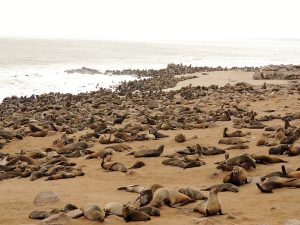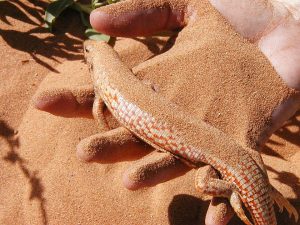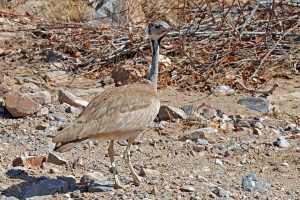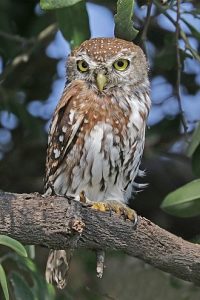Podcast: Play in new window | Download (Duration: 8:45 — 9.9MB)
It’s October, AKA Monster Month! Let’s learn about some animals of the Skeleton Coast–which sounds spooky, but actually isn’t.
Lots of brown fur seals [photo by Robur.q – Own work, CC BY-SA 4.0]:

The desert plated lizard [photo by redrovertracy, some rights reserved (CC BY) – https://www.inaturalist.org/photos/45483586, CC BY 4.0]:

Rüppell’s korhaan [photo by By Charles J. Sharp – Own work, from Sharp Photography, sharpphotography.co.uk, CC BY-SA 4.0]:

The pearl spotted owlet is cute rather than spooky, but it has a haunting call [photo by Charles J. Sharp – Own work, from Sharp Photography, sharpphotography.co.uk, CC BY-SA 4.0]:

Show transcript:
Welcome to Strange Animals Podcast. I’m your host, Kate Shaw.
It’s October at last, and that means monster month! To start us off this year, we’re going to learn about animals of the Skeleton Coast, which sounds a lot more spooky than it actually is.
The Skeleton Coast is a stretch of coastline 310 miles long, or 500 km, on the Atlantic coast of Africa. It’s part of Namibia, a huge country in southern Africa that’s mostly quite dry, with two deserts within its borders. Because the country gets so little rainfall, it has to conserve water for its people, animals, and crops, so the government is serious about conservation and natural resources. It’s home to one of the most cutting-edge water treatment plants in the world, and since the government’s establishment in 1993, it’s been working to help farmers and citizens in general to practice sustainable natural resource management. It’s also a beautiful part of the world, with amazing geography, and animals and plants found nowhere else in the world, so eco-tourism has been increasing, which helps the economy.
Namibia is also home to the San people, who call the Skeleton Coast “the land god made in anger.” The northern part of the coast is blocked off from land by huge sand dunes, while the southern part is rocky. To get there, you have to cross a desert, and then cross a treacherous marsh that’s hundreds of miles across. Then to get home, you have to go back the way you came across the marsh and the desert, because launching a boat from the Skeleton Coast is impossible if you don’t have a powerful engine.
The sea along the Skeleton Coast is treacherous, with lots of rocks offshore, extremely heavy surf, and frequent thick fogs. There are around a thousand shipwrecks visible along the coast, with the oldest dating to the 1530s, and thousands more documented that aren’t visible or haven’t been found yet. Ships still wreck there sometimes.
Animals do live along the Skeleton Coast, especially seals. The brown fur seal, also called the Cape fur seal, has a huge colony in the northern part of the coast, which is a national park. The brown fur seal lives in various parts of southern Africa, with a subspecies that also lives on some islands off southeastern Australia and Tasmania. A big male can grow 7 ½ feet long, or 2.3 meters, and as you can probably guess from its name, it’s mostly brown in color. Males have a short mane on the neck that’s usually darker than the rest of its fur. It has magnificent long whiskers, especially males.
The brown fur seal mainly eats fish, but it also likes squid and will eat other animals like crustaceans and even birds. It can dive deeply and stay underwater for over seven minutes. It spends most of its life in the water, mainly only coming out on land to breed, give birth, and take care of the babies.
The seals used to be killed for their fur, but this was outlawed in Namibia in 1990 except by special permit, which has allowed the seals’ numbers to increase. The Skeleton Coast is named that mainly because of the massive amounts of seal bones that fur hunters left behind after killing and skinning seals.
Unfortunately, something the rocks around the Skeleton Coast collect are plastic debris, especially fishing debris like nets. So many brown fur seals get caught in the debris and drown that a group of volunteers called Ocean Conservation Namibia go out almost every day to help untangle seals.
The Skeleton Coast doesn’t get any rain to speak of, or only trace amounts in any given year, but it does get thick sea fogs. Most of the plants along the coast are succulents and lichens that don’t need a lot of moisture. A lot of larger animals that hunt seals along the coast actually live farther inland, like hyenas and lions. The animals that live year-round on the coast are much smaller.
That includes the desert plated lizard, which is only found in parts of Namibia and Angola. It’s a slender but strong lizard that can grow over 6 inches long, or 16 cm, not counting its long tail. It’s mainly the color of sand, tan or orange and gray, or gray-white, or some other similar variation, with a white belly, and this is because it lives on sand dunes.
The sand dunes are covered with scrubby vegetation, so in the daytime the lizards come out and eat anything they can find among the plants or in the sand, from seeds and other plant materials to insects and other arthropods. If a potential predator approaches, the lizard will dive into the sand to hide. Its scales are smooth and its legs are short, which allows it to “swim” through sand efficiently and fast. The desert plated lizard lives in small colonies, and although it only lives in this one small part of Africa, it’s extremely common throughout its territory.
A lot of birds visit the skeleton coast—306 of them, in fact, including Rüppell’s korhaan, a species of bustard that only lives in Namibia. It’s a gray and brown bird with black and white markings, with a long neck and fairly long legs. Its body is chunky but its neck is very thin, which makes it look slightly weird but very cute. It mainly eats insects, especially termites, but it will also eat small animals like lizards when it can find them, and it also eats seeds and other plant material. It’s small for a bustard, because bustards are pretty big birds, with the largest species, the great bustard that lives in parts of Europe and Asia, standing over three feet tall, or about a meter. Rüppell’s korhaan is about a third of that size.
Let’s finish with another bird that’s a little more spooky, considering that it’s October. It’s the pearl-spotted owlet, a little owl that’s found throughout much of sub-Saharan Africa, including along the Skeleton Coast. It’s a very small owl, barely more than 8 inches long, or 21 cm. It’s brown with lots of white speckles and streaks, yellow eyes, and two black spots on the back of its head that look like MORE EYES. It shares this trait with some other species of owl, including the northern pygmy owl of western North America, and in fact the two owls belong to the same genus, so they’re closely related.
The pearl spotted owlet is active during the day, but it mostly hunts at night. Since it’s such a small owl, barely larger than a typical songbird, it eats lots of insects, but it will also eat other small birds, bats, lizards, and any other small animal it can catch.
It’s not a very spooky-looking owl, despite having eye spots on the back of its head, but it has a spooky call. Listen to this and be glad you’re not a little bat hearing this sound and wondering if you’re in danger:
[owl call]
You can find Strange Animals Podcast at strangeanimalspodcast.blubrry.net. That’s blueberry without any E’s. If you have questions, comments, or suggestions for future episodes, email us at strangeanimalspodcast@gmail.com. We also have a Patreon at patreon.com/strangeanimalspodcast if you’d like to support us for as little as one dollar a month and get monthly bonus episodes.
Thanks for listening!